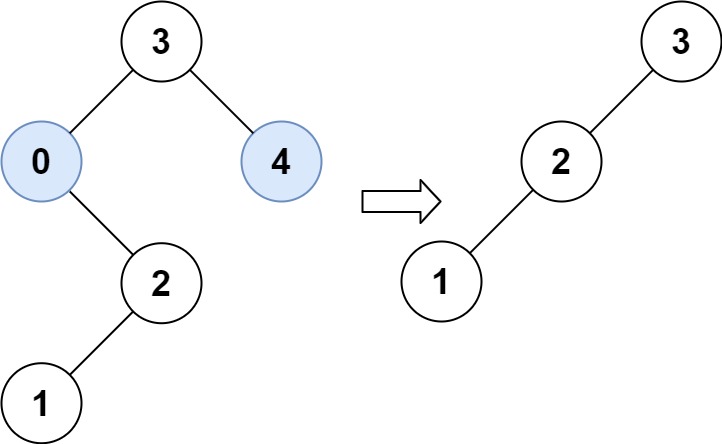Given the root of a binary search tree and the lowest and highest boundaries as low and high, trim the tree so that all its elements lies in [low, high]. Trimming the tree should not change the relative structure of the elements that will remain in the tree (i.e., any node's descendant should remain a descendant). It can be proven that there is a unique answer.
Return the root of the trimmed binary search tree. Note that the root may change depending on the given bounds.
Example 1:

Input: root = [1,0,2], low = 1, high = 2 Output: [1,null,2]
Example 2:

Input: root = [3,0,4,null,2,null,null,1], low = 1, high = 3 Output: [3,2,null,1]
Example 3:
Input: root = [1], low = 1, high = 2 Output: [1]
Example 4:
Input: root = [1,null,2], low = 1, high = 3 Output: [1,null,2]
Example 5:
Input: root = [1,null,2], low = 2, high = 4 Output: [2]
Constraints:
- The number of nodes in the tree in the range
[1, 104]. 0 <= Node.val <= 104- The value of each node in the tree is unique.
rootis guaranteed to be a valid binary search tree.0 <= low <= high <= 104
修剪二叉搜索树。
给你二叉搜索树的根节点 root ,同时给定最小边界low 和最大边界 high。通过修剪二叉搜索树,使得所有节点的值在[low, high]中。修剪树不应该改变保留在树中的元素的相对结构(即,如果没有被移除,原有的父代子代关系都应当保留)。 可以证明,存在唯一的答案。
所以结果应当返回修剪好的二叉搜索树的新的根节点。注意,根节点可能会根据给定的边界发生改变。
来源:力扣(LeetCode)
链接:https://leetcode-cn.com/problems/trim-a-binary-search-tree
著作权归领扣网络所有。商业转载请联系官方授权,非商业转载请注明出处。
思路是递归。题意是给了low和high两个边界,请你去掉BST中节点值不在这个范围内的节点但是保持其他节点的相对关系。思路大概是如下几点
如果root为空,就返回root
如果root不为空且root.val < low则去看右子树
如果root不为空且root.val > high则去看左子树
递归地去检查root的左孩子和右孩子
时间O(n)
空间O(n)
Java实现
1 /** 2 * Definition for a binary tree node. 3 * public class TreeNode { 4 * int val; 5 * TreeNode left; 6 * TreeNode right; 7 * TreeNode() {} 8 * TreeNode(int val) { this.val = val; } 9 * TreeNode(int val, TreeNode left, TreeNode right) { 10 * this.val = val; 11 * this.left = left; 12 * this.right = right; 13 * } 14 * } 15 */ 16 class Solution { 17 public TreeNode trimBST(TreeNode root, int low, int high) { 18 // corner case 19 if (root == null) { 20 return null; 21 } 22 if (root.val < low) { 23 return trimBST(root.right, low, high); 24 } 25 if (root.val > high) { 26 return trimBST(root.left, low, high); 27 } 28 root.left = trimBST(root.left, low, high); 29 root.right = trimBST(root.right, low, high); 30 return root; 31 } 32 }
JavaScript实现
1 /** 2 * Definition for a binary tree node. 3 * function TreeNode(val, left, right) { 4 * this.val = (val===undefined ? 0 : val) 5 * this.left = (left===undefined ? null : left) 6 * this.right = (right===undefined ? null : right) 7 * } 8 */ 9 /** 10 * @param {TreeNode} root 11 * @param {number} low 12 * @param {number} high 13 * @return {TreeNode} 14 */ 15 var trimBST = function (root, low, high) { 16 // corner case 17 if (root === null) { 18 return null; 19 } 20 if (root.val < low) { 21 return trimBST(root.right, low, high); 22 } 23 if (root.val > high) { 24 return trimBST(root.left, low, high); 25 } 26 root.left = trimBST(root.left, low, high); 27 root.right = trimBST(root.right, low, high); 28 return root; 29 };